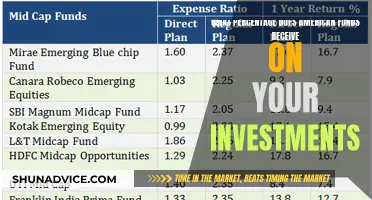Tracker funds, also known as index funds, are a type of investment fund that aims to replicate the performance of a particular stock market index. For example, the FTSE 100 or the S&P 500. Tracker funds are passively managed, meaning fund managers do not actively select stocks they believe will offer the best potential for long-term growth. Instead, the fund aims to mirror the composition of the chosen index.
Tracker funds are a popular investment choice due to their low cost, diversification benefits, and potential for steady growth. However, they are vulnerable to market crashes and have limited potential for outperforming the market.
When choosing a tracker fund to invest in, it is important to consider factors such as the fund's fees, investment strategy, and geographic focus.
| Characteristics | Values |
|---|---|
| Investment type | Mutual fund or exchange-traded fund (ETF) |
| Investment aim | Replicate the performance of a market index |
| Investment management | Passive/no active management |
| Investment selection | Based on a preset basket of stocks, or index |
| Investment insights | Insights into the performance of stocks as a whole |
| Investment benefits | Ownership of a wide variety of stocks, greater diversification, lower risk, low cost |
| Investment risks | Vulnerable to market crashes, not responsive, limited potential for outperformance |
| Best time to buy | When prepared to hold for the long term |
What You'll Learn

Tracker funds are a cheap, simple investment
Tracker funds, also known as index funds, are a type of mutual fund or exchange-traded fund (ETF) that aims to replicate the performance of a particular market index, like the FTSE 100 or the S&P 500. Instead of trying to beat the market, these funds simply aim to mirror its performance, often by investing in every stock in the index. This passive approach means there's no need for a fund manager, keeping costs low.
The benefits of tracker funds include:
- Low cost: Tracker funds are very cost-effective as they are largely managed by computer algorithms, so there are no fund manager fees. The average annual management fee is extremely low, at around 0.06%.
- Diversification: Tracker funds offer instant diversification as they give you access to a wide range of stocks or bonds in one simple investment. For example, one share of an S&P 500 index fund provides ownership in hundreds of companies.
- Steady growth: Tracker funds can be a good option for long-term investors as they offer the prospect of steady growth. They are a way to hedge against a volatile stock market and have delivered solid returns over time. The S&P 500, for instance, has averaged around 10% annual returns over the long term.
- Performance: Tracker funds are popular with investors as they deliver attractive returns. While they won't outperform the market, they also won't underperform it. So, if the FTSE 100 rose by 5% in a year, an FTSE 100 tracker fund would also rise by just under 5% once fees are factored in.
- Simplicity: Tracker funds are a simple, low-maintenance investment option. They don't require a lot of knowledge about investing or financial markets, making them suitable for beginners.
Overall, tracker funds are a cheap and simple investment option that can provide diversification and steady growth to your portfolio. They are a good choice for long-term investors who want a passive approach to investing in the stock market.
The Best Time to Invest in Funds: Morning or Evening?
You may want to see also

They aim to mimic the performance of the stock market
Tracker funds, also known as passive or index funds, are a type of mutual fund that aims to replicate the performance of a particular stock market index. They are a cheap and simple investment fund that follows the price of an index up and down over time.
Index tracker funds come in a variety of guises. Some track particular stock market indices, while others may focus on a specific industry or sector (such as technology or healthcare), countries, or particular investing styles (such as ESG).
For example, the FTSE 100 is an index that contains the largest 100 companies listed on the UK stock market. The S&P 500, the Dow Jones Industrial Average, and the Nasdaq are other major indexes.
There are two main ways that an index fund can track an index: full replication and statistical sampling (also known as partial replication). Full replication involves a fund buying all the components of a particular index, in proportion to the size of each company within the index. Partial replication, on the other hand, involves a fund investing in a representative sample of companies that feature on a particular index.
Tracker funds are a popular investment choice as they offer investors exposure to a wide variety of shares, often at a low cost. They are also one of the simplest ways to invest, as there is no fund manager to pay.
- IShares Core FTSE 100 ETF: This exchange-traded fund (ETF) tracks the performance of the FTSE 100, the UK's index of leading companies traded on the London Stock Exchange. It offers investors the ability to generate income, with a current yield of 3.5% (variable) and a low annual fund charge.
- IShares Core MSCI EM IMI ETF: This fund tracks the MSCI Emerging Markets Investable Market Index, providing exposure to emerging markets such as Brazil, South Africa, China, and South Korea. It offers investors the potential for strong economic growth and stock market appreciation over the long term.
- IShares MSCI World SRI ETF: This ETF tracks an index of stocks from across the globe, focusing on companies that meet certain environmental, social, and governance (ESG) criteria. It offers investors a low-cost way to gain exposure to global stock markets featuring companies run in an ethical way.
- Vanguard FTSE UK Equity Income Index Fund: This fund aims to track the performance of the FTSE 100 index and is reviewed every six months. It has an ongoing cost of 0.14% and a KIID risk score of 6.
- IShares US Equity Index Fund: This fund has an ongoing cost of 0.05% and a KIID risk score of 6. It aims to track the performance of the US stock market.
- Vanguard U.S. Equity Index Fund: This fund tracks the performance of the S&P Total Market Index, offering exposure to large, mid, and small-size companies traded on the New York Stock Exchange and the Nasdaq. It has low ongoing charges of 0.10% and is given a risk rating of 6 out of 7 by Vanguard.
Choosing the Right Brokerage: Investment Funds Explained
You may want to see also

There are different types of tracker funds
Tracker funds, also known as passive or index funds, are a type of investment fund that tracks the performance of a particular stock market index. They aim to replicate the returns of their chosen index, rather than trying to beat it. This makes them a passive investment strategy, and they are often managed by computer algorithms rather than human fund managers. As a result, they tend to be much cheaper than actively managed funds.
There are two main types of tracker funds: exchange-traded funds (ETFs) and open-ended investment companies (OEICs). ETFs are traded on the stock market, whereas OEICs are not. ETFs are often favoured due to their greater flexibility—they can be bought and sold in the same way as ordinary shares.
There are hundreds of different indices that tracker funds can follow. Some track the markets of whole countries, while others focus on individual industries or large geographical regions like Europe or the Far East. Here are some examples of different types of tracker funds:
- Country-specific funds: These funds track the performance of a particular country's stock market index. For example, a fund might follow the FTSE 100 in the UK, the S&P 500 in the US, the Nikkei in Japan, or the Hang Seng in Hong Kong.
- Industry-specific funds: These funds focus on a specific industry or sector, such as technology, healthcare, or energy. For instance, a fund might track the performance of the Nasdaq index, which is heavily weighted towards technology companies.
- Regional funds: These funds invest in a specific geographical region, such as Europe or the Far East.
- Commodity or bond funds: These funds track the performance of commodities like gold or government bonds.
When choosing a tracker fund, it's important to consider factors such as the fund's fees, investment strategy, level of diversification, and risk profile. It's also crucial to remember that tracker funds will never outperform the market or index they are linked to—they can only ever match its performance, minus the fund's annual charge.
Skills for Investment Fund Managers: Expertise for Success
You may want to see also

They are a good way to diversify your portfolio
Tracker funds are an excellent way to diversify your portfolio.
Firstly, they are a low-cost way to gain exposure to a wide variety of shares. By tracking a particular index, they offer investors an opportunity to invest in a broad range of shares or bonds at a low cost. This means that you can gain access to hundreds of companies across the globe, including large and medium-sized companies in developed and emerging markets.
Secondly, tracker funds are a simple investment option. They are passively managed, meaning that fund managers are not actively selecting stocks they believe have the best potential for long-term growth. Instead, they aim to mirror the composition of a particular index, which can include companies from specific industries or large geographical regions like Europe or the Far East. This passive approach makes tracker funds a straightforward way to gain exposure to the stock market and its excellent long-term returns.
Thirdly, tracker funds offer instant diversification. With one purchase, investors can own a wide range of companies and reduce the risk of being overexposed to a specific asset or industrial sector. For example, the Vanguard Global Bond Index Fund invests in investment-grade and government bonds from around the world, while the iShares Emerging Markets Equity Index Fund invests in a wide range of sectors in emerging markets, including banks, technology, software, energy and retailers.
Finally, tracker funds are a good option for long-term growth. They have the potential for steady growth over the long term, making them a way to hedge against a volatile stock market. For example, the Vanguard LifeStrategy 100% Equity Fund has a long-term growth focus, with a value that grew by 13% in 2023.
In summary, tracker funds are a good way to diversify your portfolio as they offer low-cost exposure to a diverse range of companies and industries, providing a simple and effective way to achieve long-term growth.
Trust Fund Investment Strategies: Where to Begin?
You may want to see also

They are a passive investment approach
Tracker funds are a passive investment approach. They are a cheap and simple way to invest, and your money will follow the price of an index up and down over time. Tracker funds are also known as passive or index funds. They aim to replicate the performance of a particular market or index, such as the FTSE 100 or the S&P 500.
Tracker funds are run using computer algorithms, so they are much cheaper than actively managed funds, which employ a team of active managers. Actively managed funds are more complex and incur higher fees as they involve a great deal of research and a fund manager picking specific stocks to try to beat the performance of an index.
Tracker funds are also a more passive investment approach than active funds, with less trading in and out of investments. This means there is less opportunity to take advantage of market opportunities, but it also means you are less likely to lose money.
Tracker funds are a good option for investors who want to take a passive investing approach, with low charges and a simple, diversified investment. They are also a good choice for those who want to invest in the stock market but don't want to spend a lot of time picking a fund or paying for a financial advisor.
Tracker funds are not immune to market crashes, so in some cases, individual stocks could perform better than the index in times of economic difficulty. It's also important to remember that a tracker fund can never outperform the market or index it is linked to – as the name suggests, it will only ever follow it.
Mutual Fund Investment Strategies: Where to Invest?
You may want to see also
Frequently asked questions
A tracker fund, also known as an index fund, is a cheap and simple investment fund that aims to replicate the performance of a particular stock market index. Tracker funds are often very low cost as they are run using computer algorithms and don't require costly research and managers.
Tracker funds work in two main ways: full replication and statistical sampling (or partial replication). Full replication involves creating a stock portfolio that includes all the shares in the index at their relevant weights. Statistical sampling, on the other hand, involves the fund analysing the index and working out its investments so that it is very confident of achieving a performance that is very close to it.
Tracker funds are popular because they offer investors ownership of a wide variety of stocks, greater diversification, lower risk and attractive returns, all at a low cost.
Tracker funds are vulnerable to market crashes and have limited potential for outperformance. They also offer less flexibility as there isn't a large amount of trading in and out of investments.







